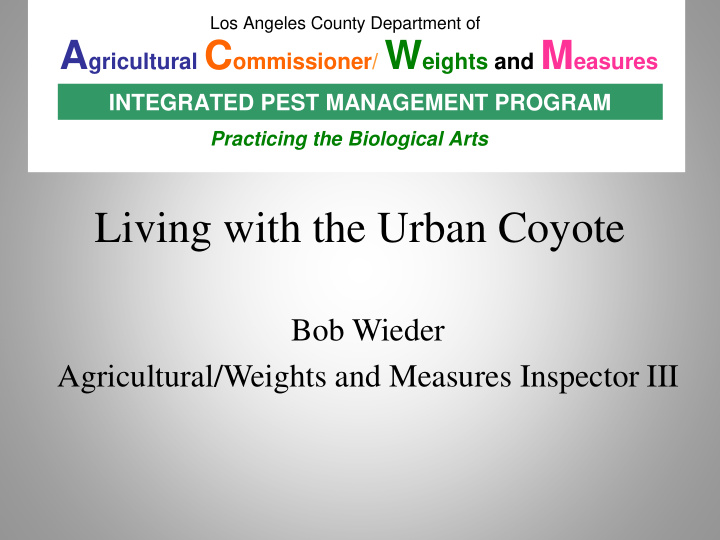



Los Angeles County Department of A gricultural C ommissioner/ W eights and M easures INTEGRATED PEST MANAGEMENT PROGRAM Practicing the Biological Arts Living with the Urban Coyote Bob Wieder Agricultural/Weights and Measures Inspector III
Coyote Facts Coyotes are a native mammal who have been know to exist in LA County for at least the last 46,000 years
Coyote Facts • Coyotes diet vary : small rodents, rabbits, raccoons, birds, berries, fruit, vegetables, garbage, compost, outdoor pet food and small unprotected pets • They weigh in at between 15 and 40 pounds • Young are born in mid to late Spring • Generally, litters are from 4 to 7 pups and will stay with the parents until late summer
Coyote Behavior Although generally most active between dusk and dawn, they can be seen at any time during the day.
Coyote Behavior Although they are shy animals by nature, they are also extremely curious and will often be seen observing human behavior from what they consider a safe distance
Coyotes are living in our neighborhoods
Intentional Feeding
Los Angeles County Code Title 10 ANIMALS Chapter 10.84 FEEDING OF CERTAIN PREDATOR ANIMALS 10.84.010 Providing food for certain rodents or predator animals prohibited • A. Except as otherwise provided for herein, no person shall feed or in any manner provide food to a nondomesticated rodent or a nondomesticated mammalian predator. • B. For purposes of this chapter: 1 . “Rodent” includes ground squirrel 2 . “Mammalian predators” includes coyote, raccoon, fox and opossum (Ord. 81-0029U ᶊ 1 (part), 1981)
Coyote Safety Tips • Keep garbage cans closed and secure • Keep small pets indoors especially at night and keep pet food indoors or remove when pets complete their meals outside • Pick up fallen fruit and cover compost piles • Put away bird feeders at night to avoid attracting rodents and other coyote prey
Coyote Safety Tips • Clear brush and dense weeds from around your property • Have a wall or fence at least six feet high around your backyard • Enlist your neighbors as a neighborhood wildlife watch • Teach children to never approach coyotes or other wild animals
If You See A Coyote • Admire it from afar, but don’t encourage them • Never offer it food • Don’t turn your back, ignore or run from a coyote • Carry a walking stick or noisemaker at night or during an early morning walk • Keep your pets next to you on a leash if they are with you
If A Coyote Approaches You • Make eye contact • Make yourself as authoritative and big as possible • Try to scare it and appear threatening • Clap, shout, make loud noises, wave your arms • Pick up small objects, such as a stone and throw it at the approaching coyote or spray it with water
If A Coyote Approaches You • Do not turn your back on a coyote; to get away, face the coyote and carefully back away slowly
If A Coyote Attacks Call 9-1-1 if a coyote or other wild animal attacks or threatens to attack a human
Who to Contact Los Angeles County Department of Agricultural Commissioner/Weights and Measures Integrated Pest Management Division (626) 575-5462 acwm.lacounty.gov
A L ast Word……. Remember, it is humans that have “taught” coyotes to associate us with food and it is only through our efforts that we can minimize human/wildlife conflicts.
Recommend
More recommend